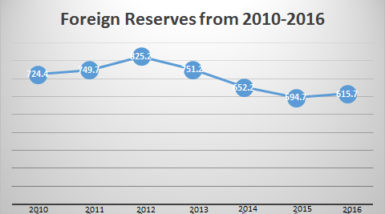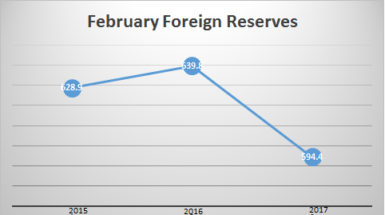Guyana’s net foreign reserves have fallen below US$600 million for the second time in the last two years.
A statistical abstract on the local banking system, published by the Bank of Guyana (BoG), shows that as of the end of February, Guyana holds US$594.4 million in Net International Reserves.
According to the International Monetary Fund (IMF), foreign currency reserves are maintained so as to increase a country’s resilience to shocks that may originate from global financial markets or within the domestic financial system. Reserve management is a process that ensures that adequate official public sector foreign assets are readily available to and controlled by the authorities for meeting a defined range of objectives for a country.
In recent months, concerns have been raised by the business sector about the availability of foreign exchange in the local market.

There have been repeated claims that there is a foreign exchange shortage and calls for the government to release some of the reserves into the economy so as to bolster a falling exchange rate.
Both the business community and members of the public have complained about having to settle transactions at a rate of GY$230 to US$1 and higher, however, the government and the Central Bank have played down these concerns, while claiming that the central reserves remain adequate to meet any demands of the market.
Despite this, Minister of Finance Winston Jordan and Governor of BoG Dr Gobind Ganga have been reluctant to commit to a release of currency from the reserves though the Guyana Manufacturing and Services Association has asked them to do so.
In March, they made a guarded promise to release some of the reserve into the market if the commercial banks were to “weed out” illegitimate requests for foreign currency.
Since January, Jordan has maintained that “a climate of speculation and hysteria” has been cultivated by some market participants and has led to unwelcomed developments.

Speaking at the opening of the new Citizens Bank Headquarters on Camp Street, he said these developments include major companies seeking to pay for imports and repatriate profits earlier than required in the usual business cycle, which has created a surge in demand for foreign currency, thereby clogging the market.
On the supply side, the minister explained that some exporters are withholding sales of foreign currency to the system, “possibly in the hope of provoking a depreciation of the domestic currency so as to maximise their Guyana dollar profits.”
Additionally, he said the situation has been aggravated by “the action of some net foreign exchange earners, who are demanding foreign currency from the market while hoarding their foreign currency holdings.”
“Some companies are even purchasing foreign exchange to facilitate trade for their counterparts outside of Guyana, while a few exporters and importers are conducting foreign exchange transactions bilaterally, outside of the foreign exchange market,” the minister said before adding that “large spreads between the buying and selling rates for foreign currency, especially by bigger banks, have led to some level of disintermediation.”
These banks, he explained, act as the pacesetters in the pricing of foreign currency and interest rates and have great influence in creating uneven competition for smaller banks.
Cumulatively, these developments have artificially stressed the foreign exchange market and have the potential of destabilising Guyana’s fragile economy, he warned.
Jordan also maintained that the level of foreign exchange in the system indicates that current demand can be adequately met without speculation.
While there is no stated level of resources adequate to meet the needs of the Guyanese economy, international rule of thumb as maintained for years by the IMF is that a state’s reserves should equal 12 weeks (3 months) worth of its imports.
Using this criteria Guyana is presently able to facilitate 4.6 months of merchandise import; if import figures remain similar to those of 2016. This is approximately 1.6 more months that the international advised period.
This calculation was arrived at using figures released in the BoG quarterly report, published in September, 2016. According to the report, in the first nine months of 2016 the country imported US$1.169 billion in merchandise for trade. This figure means that in one of the nine months, the country spent approximately US$129.9 million in imports.
If these calculations are accurate and Guyana continues to face challenges with attracting and maintaining foreign exchange in the market, the foreign exchange reserves could fall further.





